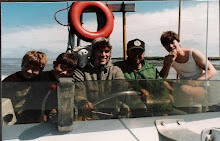


February 23-26, 2009 Indian Ocean
Four class days on the Indian Ocean with papers to write, chapters to read, quizzes to take. I was surprised that it will take us almost as long to cross it as it did for the Atlantic. The sailing has been smooth for Les and me. Today the ship slammed down some, and Wendy felt ill. We have had to change our clocks every night, setting them ahead one hour. Barrett is growing – he got new pants and new shoes in South Africa. He’s getting better at potty training, and he’s learning more about other people and their feelings. We have an alphabet Les has been making along the wall of our cabin; it’s already to Pp. Under each letter we put people’s pictures from the ship or from home, a lion, or flying fish, etc. Barrett’s journal is getting plump with experiences.
February 27, 2009 Mauritius
We sailed into Port Louis at 7 AM and are now leaving at 9 PM. Les and I went on an adventure trip today. Flic en Flac was our first stop, a soft sand beach on a blue lagoon. First we went to buy some Mauritian rum (sugar cane is grown all over the island), and then I swam in the warm Indian Ocean. Next we drove to Parc Aventure Chamarel in the Savanne Mountains. Flower bushes rimmed the sugar cane fields, pineapples grew, and coffee plantations thrive in this area. Les and I roped up (pictured) and walked over several swinging gap-plank bridges, one without handhold ropes. The vegetation reminded us of Hawaii, and we saw a beautiful fire engine red bird with black wings. The students adventured more strenuously on two-rope bridges and a zip line.
Mauritius was an uninhabited island when the Portuguese first began plying the Indian Ocean. The Dutch settled here, but later abandoned it. (Were they they ones who ate up all the dodo birds? I think.) The French took possession in 1715, losing it to the English in the Napoleonic Wars. The British freed the sugar slaves. At that time some of the slaves were in hiding on a steep mountain. English soldiers went up to tell them they were free, but, fearing capture for more years of slavery, the slaves jumped and plunged to their deaths. The mountain is called Mt. Le Morne (from the English word mourn). Today English is the official language, but French is most common. Our guide speaks five languages. I am in awe of the people of the world and their language skills!
*February 28 – March 3, 2009 Indian Ocean
The sea was orange oil this morning as the sun rose amid mirage cloud-islands. Sunset was almost as amazing. The sea is calm, the pool was filled, and the water did not slosh out in great gallons, raining down on the dining deck. The ship had a crazy Seven Seas Olympics day. The students are divided by deck into seas: Black, Baltic, Red, Mediterranean, Aegean, Adriatic, and Yellow. The adults, staff, faculty, families were called the Oddie-Cs. The contests were everything from volleyball to mashed potato sculpting to Sudoku. Les did the wheelbarrow race; Matthew was in the three-legged race with Wendy; Barrett tried the limbo; and Wendy & I joined the synchronized swimming contest (pictured).
I watched a red-footed booby resting on the mast. (Les said he’d seen enough boobies on board, thank you.) Another booby flew by in the early morning, and the two went off over the ocean fishing.
There was a Dean’s wine-tasting one night. The Turkish crew-member who led the commentary gave us tips on the ten wines and how to sample them. On Les’s birthday we were invited to Captain Jeremy Kingston’s dinner. His sense of humor and stories were a delight. The black forest cake slice for Les had a single candle, and the crew sang happy birthday. Second biology test, and I think I got a 78, which is my personal best. Our writing class is reading The God of Small Things. What a writer! I have “read” this book before on tape. Now I need to work on my long piece for class. We are beginning to think about travel in India. I can’t keep up with us!! A lady and two girls from India are on board to help prepare us for Chennai and India.

















